Tuhina’s Adventures in Rwanda
Somak Luxury Travel commercial executive, Tuhina Sharma, recently travelled to Africa. Here is more about her Rwanda adventures, in her own words…
“Rwanda is recognised for its lush flora, thousands of rolling hills, and rich fauna, making it a popular destination for adventure-seekers and environment aficionados,” said Tuhina.
“One of the highlights of my travels was going gorilla trekking in the Volcanoes National Park. The journey into the jungle was tough but thrilling, and when we eventually came across a family of gorillas, it was a genuinely awe-inspiring sight,” she said.
Arrivals, Kigali & The Genocide Memorial

The Kigali Genocide Memorial is a place of remembrance and learning dedicated to the victims of the Genocide against the Tutsi in Rwanda.
“I found myself gazing into the misty horizon of Rwanda on a Monday morning as I flew in for a journey of a lifetime. The rolling green hills and many lakes reflecting the morning sunlight back at me filled me with excitement for what lay ahead.”
“Clearing immigration was a breeze on arrival and the pleasant morning temperatures of Kigali, the capital city of Rwanda made a promising trip start.” She reflected that changing money, drawing cash from ATMs and finding a local SIM card for her phone was all done without much fuss.
As she left the airport Tuhina was impressed by how clean the city of Kigali was. “Our guide was quick to point out the concept of “Umuganda”, which is that last Saturday of the month Rwandan citizens set aside time for a national cleanup. Citizens will clean their homes first and then as a community come together to clean public places.” Tuhina also mentioned that Rwanda has a countrywide ban on non-biodegradable plastic.
“It’s easy to see that life in Kigali is a blend of modernity and tradition, urban and rural, and is marked by a strong sense of community. Kigali is often counted as one of the safest capitals in Africa. The streets are regularly patrolled, and there’s a sense of security walking around, even at night,” explained Tuhina.
She settled at her hotel for the night, the Kigali Marriott where she was served a local drink called Skol Panache which she described as “refreshing” and “lemony” with her lunch, after which she was taken to visit The Kigali Genocide Memorial.
“Visiting the Kigali Genocide Memorial can be a deeply emotional and moving experience, as it provides a stark reminder of the horrors of unchecked prejudice and hatred. It also underscores the resilience and unity of the Rwandan people in their journey of recovery and reconciliation,” she said.
Exploration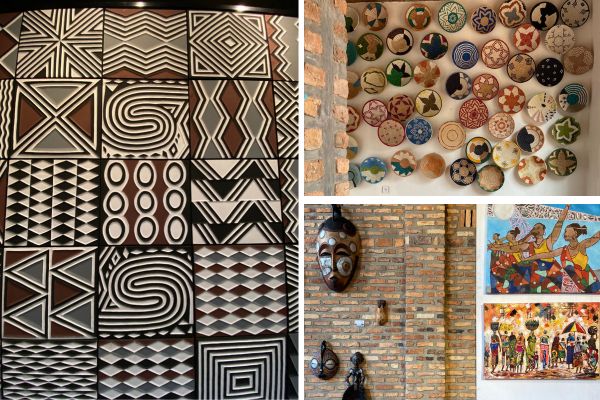
On her second day Tuhina headed out to explore Rwanda, specifically Akagera National Park in the eastern part of Rwanda, along the Tanzanian border, but on the way, she learned about the country’s rich cultural heritage.
“We made a stop at a local art gallery promoting Imigongo, which is a traditional Rwandan art form that dates to the 18th century,” said Tuhina.
“The art mainly consists of geometric patterns in black, white, and red. The distinct patterns are created using cow dung mixed with ash and then painted onto wooden boards. The cow dung provides texture and volume to the designs. The main colours used are naturally derived from earth and organic materials.”
Akagera National Park
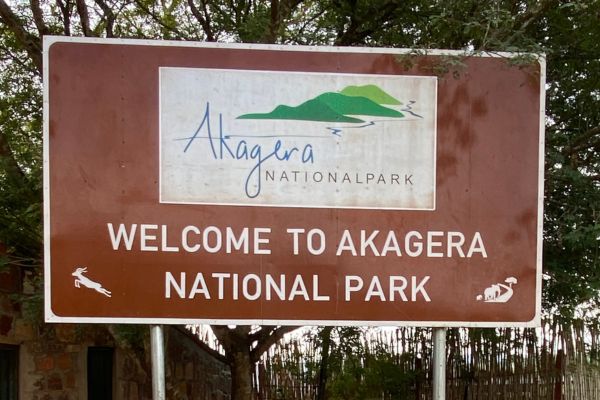 By the afternoon she was in Akagera National Park, a success story of conservation efforts that have transformed this park into a notable sustainable tourism and wildlife management model.
By the afternoon she was in Akagera National Park, a success story of conservation efforts that have transformed this park into a notable sustainable tourism and wildlife management model.
“Akagera boasts diverse wildlife, including some extremely rare-to-spot elephants, lions, giraffes, zebras, and more. It’s also home to over 500 bird species,” said Tuhina. She explained that there are many different terrains ranging from savannah to swamps including rolling highlands and lakes.
“This contributes to its rich biodiversity. After facing challenges due to poaching and human-wildlife conflict in the past, conservation efforts have led to a resurgence of wildlife populations,” she said. The park has successfully reintroduced lions in 2015 and black rhinos in 2017.
“Other than traditional 4×4 game drives, one can enjoy a thrilling experience on Lake Ihema, the largest lake in the park and a hotspot for boat safaris from which hippos, crocodiles and a variety of water birds can be spotted.”
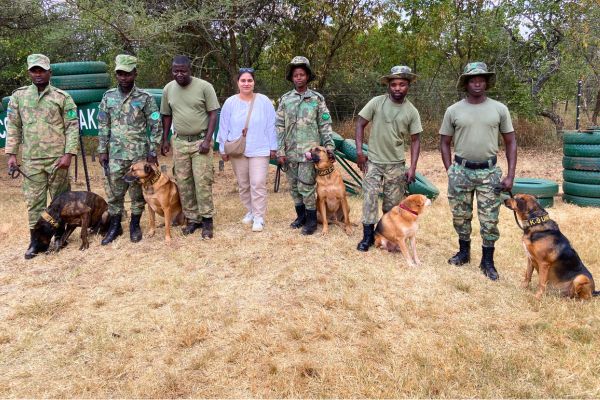
Tuhina with the K9 Anti-Poaching Rangers at Akagera National Park.
Anti-Poaching K9 Rangers
Tuhina was fortunate to be taken behind the scenes at the park headquarters. “They took us to the control room where rangers keep track of different game,” said Tuhina, adding that they also keep track of the anti-poaching efforts. “In my experience of visiting game reserves, this was a first for me where we could interact directly with rangers, and they showed us historical data on how poaching prevention takes place on the ground,” she said.
“After the visit, we were ushered into the K9 anti-poaching unit grounds, where we had a thrilling demonstration of how man and dog unite in their efforts for the smooth running of a wildlife game reserve. Seeing the trained K9 rangers run through their paces and hear about different strategies on how they are used for assisting in poaching prevention was truly a great experience.”
As if to round off a perfect day, Tuhina spent the night at Mantis Akegera Game Lodge which she described as stunningly located.
“It is perched on a ridge overlooking Lake Ihema, providing a spectacular view,” she explained. “The scenic vistas and the surrounding environment make it a peaceful retreat and great sundowner spot.”
Boat Ride Adventure

Boat tours of Lake Ihema are a great opportunity to get close to the hippos who roam the waters.
The following morning Tuhina set off on the next step of her adventure. “We set out with a packed breakfast to enjoy a sunrise boat ride. As you embark on your boat ride, expect to see hippos yawning in the early morning light, Nile crocodiles sunning themselves on the banks, and a variety of water birds like herons, kingfishers, and fish eagles.”
However, the rain decided to spoil these plans. “Strapped in our protective gear, we set off on the boat and had meagre expectations of what to expect. Despite the rain, the mist surrounding the hills was a surreal experience, I fully expected a mythical creature to emerge from the lake and keep the illusion alive.”
“After about 20 minutes the motors were cut off and in the lulled silence and rain sounds, we saw blobs emerge from the lake and were soon surrounded by hippos! The boat allows for a close encounter with these ferocious giants, and you can observe them enjoying and being lazy after a busy night of grazing.”
Tuhina said the boat experience is also a must for bird enthusiasts as there is the chance to spot over 500 species on the trip.
“Despite the rain, we also saw some Nile crocodiles. Overall, the experience was a true highlight to experience at Akagera National Park. Early morning is the best time for a boat ride on the lake because the waters are often calm, and the temperatures are cooler than during the midday heat,” advised Tuhina.
Safari Adventure
“After the boat ride, we set off for a full day south to north game drive in the park. We started our journey from the Southern Gate. Here, we were greeted by scenic vistas of rolling hills and savannah. We saw some antelopes, zebras, and giraffes grazing in the grasslands. As we travelled northwards, we drove along Lake Ihema, which was now sparkling with sunshine.
“Leaving the lake behind we ascended into the Mutumba Hills, the landscape became more rugged and offered panoramic views of the park. This highland region of the park is home to elands, roan antelopes, and occasionally lions. Akagera is also interlaced with a series of swamps and wetlands that are home to sitatungas (a rare and elusive antelope) and shoebill storks.”
“Moving on to the Nyamukari – Rwisirabo Loop & Birengero Loop (close to the border with Tanzania) which provides an opportunity to see various wildlife, including buffalo, elephants, and, if one is fortunate, lions or leopards. As we approached the northern exit, the landscape was thick bushy grasslands and acacia woodlands. This area is known for its concentrations of game, and one might spot herds of buffalos, elephants, and even some predators like hyenas. The drive concludes with an exit from North Gate. After the game drive, we returned to Kigali for a night at Kigali Marriott Hotel.”
Visiting the Palace
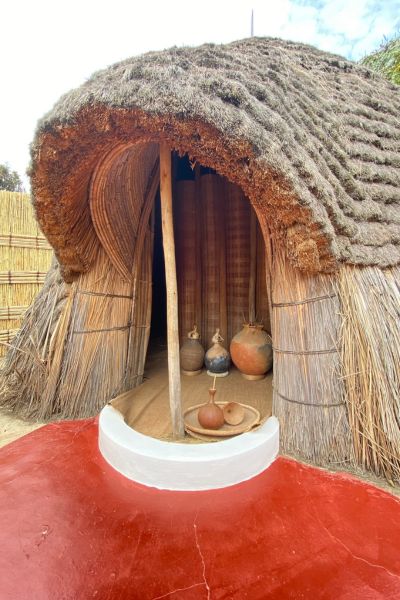
Igishu traditional architecture is constructed using traditional materials such as grass thatch, wood, and mud, showcasing the architectural style of the time.
The next day on their way through lush tea plantations on their way to Nyungwe National Park, home to one of the most well-preserved rain forests in Africa, Tuhina and her group stopped at Nyanza where the King’s Palace Museum is located.
“The King’s Palace Museum in Nyanza is a historical site that offers a glimpse into the country’s rich cultural heritage and history, particularly the history of the Rwandan monarchy. Nyanza was historically an important centre of the Rwandan monarchy. The museum is situated on the original site of the former royal palace of the Rwandan monarchy. It was built in 1932 during the reign of King Mutara III Rudahigwa. The palace served as the residence of the Rwandan kings and a place where royal ceremonies and rituals took place,” said Tuhina adding that this visit is an experience she would encourage every traveller to Rwanda to include in their journey.
For Tuhina, a highlight was observing the “Igishu” traditional architecture. “It is constructed primarily using traditional materials such as grass thatch, wood, and mud, showcasing the architectural style of the time,” she said.
The museum houses a collection of artefacts, photographs, and exhibits that provide insights into the history of the Rwandan monarchy, the royal lifestyle, and the cultural practices of the Rwandan people which allows visitors to learn about the traditional governance structure, religious beliefs, and daily life of the royal family.

Inyambo cows – long-horned cows highly regarded in Rwandan culture and have played a significant role in the country’s history and traditions.
“Another highlight here for me was the Inyambo cows,” she said explaining that Inyambo are a traditional breed of cattle native to Rwanda. “These cattle are highly regarded in Rwandan culture and have played a significant role in the country’s history and traditions. Inyambo cattle are known for their distinctive hump on their backs and their long, upward-curving horns. They are characterised by their striking appearance and are often seen as a symbol of Rwanda’s cultural heritage. Inyambo cattle have been used for various purposes, especially in cultural ceremonies,” she said.
Nyungwe National Park
Located in southwestern Rwanda, Nyungwe National Park is a diverse national park which offers canopy walks which allow visitors to explore the lush rainforest canopy from a 160-metre-long elevated walkway approximately 50 metres above the forest floor. “The canopy walk is a series of suspension bridges and walkways that take you high above the forest floor, allowing you to walk among the treetops of the ancient montane rainforest. It’s a unique opportunity to experience the park’s biodiversity from a different perspective,” said Tuhina. “This height provides an excellent vantage point for birdwatching and wildlife observation. One must have a good fitness constitution for the experience, as to access the Canopy Walk it’s about a 30 – 45 minutes downhill trek and then after the walk, one must climb up again.”
Chimpanzee Trekking Adventures
After another good night’s sleep, Tuhina was ready the next morning at 4.30am to travel back into the Nyungwe National Park for a Chimpanzee Trek. “We were met by our guide at the visitor centre and then we continued to drive for about an hour more to reach the starting point of our trek,” she said describing how villagers turned up to greet the group which they welcomed with smiles and waves to encourage them on their trek.
“I had no idea what to expect, but as our car turned a corner we caught a glimpse of a cheeky Chimp by the rocky roadside, as if they were waiting for us. It was all the fuel I needed to begin the trek! Grabbing onto my walking stick which was smoothened by the palms of many trekkers before me, we started from the farmland and walked steadily into the rain forest. What was a total experience of about 3 hours, is framed in my memory with the smoky smell of the open fire cooking in the village, the stream we precariously hopped over on wobbly rocks and slippery logs, a steady climb in rain-moistened red soil as we chased the chatter and early morning calls of primates in the wild,” said Tuhina.
About 45 minutes into their trek Tuhina’s group met up with the trackers from the forest department who trek ahead early morning as spotters. “They briefed us that beyond this point we have a chance of spotting our intelligent cousins as the family is finding a spot to enjoy their breakfast. After about 20 minutes more of the hardest trek, as the terrain was very steep and slippery, we finally camped under the canopy of a giant tree observing the chimpanzees enjoy their morning meal,” she said.

Tuhina on the Chimpanzee Trail with some of the rangers and guides.
Tuhina explained that once contact is made the group has one hour within which to observe the Chimps in their natural habitat. “Luckily for us after a quick meal, some of the Chimps moved downhill and we followed them and found another family which was much closer to observe.”
“Watching them pluck fruit, interact with different species of animals around them and cautiously observe us while we observed them was such a special experience. Then we made our way back to the village farm listening to the loud chatter of the Chimps slowly fading away as we emerged from the rain forest.”
Following their morning excursion, the group spent some time after lunch enjoying the water activities at Lake Kivu which was located close to their hotel. Here they could choose between paddle boarding or kayaking. “Being not so steady on my feet after the morning trek, I chose to do kayaking. Getting oriented, I was given a gentle push into the lake and off I went exploring the calm waters of Lake Kivu. Right in front of me was an imaginary line in the water signalling the border to Congo.”
Training Treks
Over the next few days Tuhina went on another trek which she saw as good training for her future Mountain Gorilla Trek.
“Future me would thank me for fitting in three treks in a row before I took on the task of the Gorilla trek. It is truly one of the best ways to acclimatise yourself for the big finish at the end of your Rwandan adventure,” she explained.
She and her group enjoyed some of the sights and sounds of the country she was becoming increasingly fond of. They spent more time at Lake Kivu, and enjoyed a thrilling speed boat ride across to visit a coffee plantation where she learned a lot about coffee, and how it is grown and produced.
They visited the Ellen DeGeneres Campus of the Dian Fossey Gorilla Fund which is dedicated to the conservation, protection and study of mountain gorillas in the region.
“It was a lovely space to discover the efforts made by Diane Fossey in mountain gorilla conservation and more about her early life and life in Rwanda. If you’ve seen or read Gorilla’s In the Mist then it’s a great way to see some visual recollection of her notes and clips from her archives,” said Tuhina.
She even managed, on the eve of her Gorilla Trek, to enjoy some culture at Virunga Inn Lodge. “They hosted us for a lovely evening cocktail with bonfire and traditional Rwandan folk songs and warrior dances,” she said.
Meeting the Mountain Gorilla
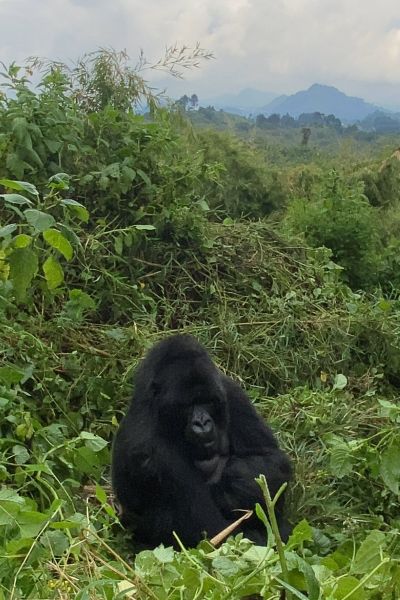
A mother Mountain Gorilla cradles her infant.
On the morning of the big event, Tuhina said she woke up calm, yet energised in time for her early start.
“We all gathered to get kitted in gaiters to protect us from mud and gloves to protect our hands from thorns while trekking. We had been advised not to wear black or deep blue as this invites bites from Tsetse flies. Wearing full-sleeved shirts is also advised to avoid stinging nettles. Armed with rain protection and a full camera battery we were off to the briefing lounge.”
Prior to the trek itself the group assembled at the briefing area where everyone’s physical fitness was taken into consideration as the group was sorted into gorilla trekking groups, usually made up of at most 8 people. This was also an opportunity to have fresh coffee or hot chocolate before heading out as well as the last place where there were proper washroom facilities.
“After the match, you are briefed about the Gorilla family you are going to meet. We were assigned the Igisha family which is one of the newer families as it split from a big group in 2014. Igisha is a family of 24 gorillas led by Silverback Igisha. After the briefing, we were told our trek would begin after about 1 hour 40 minutes of drive to the base of the trekking point,” explained Tuhina.
Porter, please?
“We knew that the trek varies from 30 minutes to 6 hours based on where the gorilla families are located. We settled in for a drive which took us through the countryside where school children were walking towards the schools and morning assemblies were taking place in school compounds. Lots of waving and shouts of good luck were passed on to us. After the long drive, we arrived at the trek base point. At this point we were given a choice to hire a porter who would assist with the trek and hold on to your belongings once you reach closer to the gorilla’s nest,” said Tuhina “I recommend and highly encourage everyone to go for hiring a porter as it gives back to the local economy and trust me halfway through the trek you would be thankful for the assistance.”
“Our trek started from the terrace farms that overlook the magnificent Nyiragongo volcano. We were briefed that the climb begins after “the wall”. It sounded so ambiguous in the verbal briefing, till we reached the wall! It’s a stone barrier between the park parameters and the villages that reside on the foothills of the volcanoes. The wall is not to keep the gorillas away it’s there to keep the cape buffaloes away which are deadly when encountered in the wild. A deep entrapment is dug behind the stone wall to stop the cape buffaloes,” explained Tuhina.
“It’s a steady ascent right after the wall. You can feel the altitude, I was huffing and puffing within a few minutes. You walk through a very packed trail. The ground is layered with bamboo which makes it tricky to navigate. I much preferred the muddy slip-and-slide I had during the chimpanzee trek to this! The path is lined with ivy, the porter assists by using their sticks to push the ivy and stinging nettled away from your path.”
“After about an hour of steady climbing, we finally saw a bit of the skyline after the dense jungle. At this point, we met the trackers who had hiked the trail early in the morning. The trackers hike ahead to find the gorilla nesting spots and the guide stays connected with them through radio. These guys are the cool cats keeping track of gorilla behaviour and their nesting spots,” explained Tuhina.
Like with the chimp trek, visitors to the jungle are only allowed one hour of observing the gorillas once they first make contact. The trackers stay back to note the last resting spot of the gorilla pack and then hike to the same spot the next day to ensure a good sighting for the trekkers.
“I’ll never forget my first contact with Silverback Ishiga who was resting after his breakfast framed by the volcanoes behind in the distance. It’s an experience still fresh in my memory and I can recall exactly how I felt when I first breathed the same air as this gentle giant,” said Tuhina. “We had an hour to walk around their nesting territory and saw a total of 15 gorillas! Observing the mothers allowing the young ones to observe us with caution was so thrilling.”
“After our time was up, we made our way back downhill and headed back to our hotel. Over lunch, it was so amazing to hear everyone’s thoughts on their experience. After lunch we had a long drive back to Kigali, by this time we had familiarised ourselves with the top 40 on Rwandan radio and the fun beats of the latest Rwandan songs (sung both in French and Kinyarwanda) kept us company till we arrived back in the city to catch our late evening flights back home!”
Keen to visit Rwanda?
Has Tuhina’s story inspired you to follow in her footsteps and visit this amazing and often overlooked African country?
Check out our website for more on travel to Rwanda, which is also a great addition to a Kenya or Tanzania Safari.
Contact
Somak House
Harrovian Business Village
Bessborough Road
Harrow On the Hill
HA1 3EX
Tel: +44 20 8423 3000
Fax: +44 20 8423 7700
Email: info@somak.com
Opening times
| Mon - Fri | : | 9am to 6pm |
| Sat - Sun | : | Closed |






